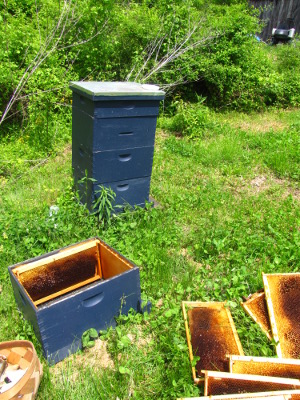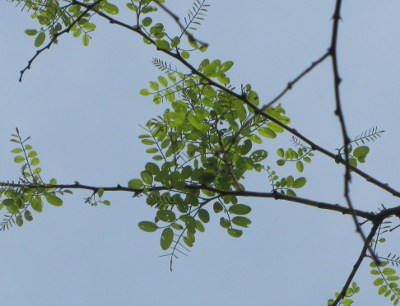
Hive split
 On
April 21, our
hive had four full frames of brood, and I figured it might take
them about a week to reach the six frames I needed for an even
split. When
the week was up, though, the weather turned windy and rainy, so I
didn't get back into the hive until eleven days later...at which point
there were a whopping eight frames of brood!
On
April 21, our
hive had four full frames of brood, and I figured it might take
them about a week to reach the six frames I needed for an even
split. When
the week was up, though, the weather turned windy and rainy, so I
didn't get back into the hive until eleven days later...at which point
there were a whopping eight frames of brood!
I brushed dead bees out
of one of the hives
that perished over the winter and filled the brood box up
with two frames of pollen, five frames of brood (two of which were
halfway honey), and three frames of honey. I didn't bother
brushing any bees into this new brood box because there were scads of
workers along for the ride already, especially once I took a whole
super of honey (full of more bees) off the top of our healthy hive to
add to its daughter hive.
The workers who were out
foraging when I messed up their home will all go back to the old hive,
and
any foragers who I carried to the new hive during the split will
probably drift back there as well. That's no big deal, though,
because
I included extra honey in the young hive to make up for the lack of
foragers. I also made sure that there's plenty of capped brood in
the young hive that
will hatch into new foragers within a couple of weeks, so they'll be
socking away honey before long.
 When doing an even hive
split, you don't have to find the queen, so I don't know whether she's
still hanging out in the old hive or has moved in with the newcomers in
the young hive. Wherever she's at, that hive will soon be back to
normal, gathering nectar and pollen from the big producers that are
about to bloom (black locust and tulip-tree). Meanwhile, the
queenless hive will be set back about three weeks as the bees figure
out they're queenless (a day or two), earmark a few of the eggs as
royalty (one to three days), feed the new princesses royal jelly during
their 5 day larval stage, and wait out their eight day pupal
stage. Queenless hives usually hedge their bets by making more
than one queen cell, but the queen who emerges from her capping first
will systematically kill her competitors. She soon goes on a
mating flight and then starts laying, bringing the hive back into
production.
When doing an even hive
split, you don't have to find the queen, so I don't know whether she's
still hanging out in the old hive or has moved in with the newcomers in
the young hive. Wherever she's at, that hive will soon be back to
normal, gathering nectar and pollen from the big producers that are
about to bloom (black locust and tulip-tree). Meanwhile, the
queenless hive will be set back about three weeks as the bees figure
out they're queenless (a day or two), earmark a few of the eggs as
royalty (one to three days), feed the new princesses royal jelly during
their 5 day larval stage, and wait out their eight day pupal
stage. Queenless hives usually hedge their bets by making more
than one queen cell, but the queen who emerges from her capping first
will systematically kill her competitors. She soon goes on a
mating flight and then starts laying, bringing the hive back into
production.
That's assuming all goes
well. I'm keeping my fingers crossed that within a month, we'll
have two fully active hives instead of one.
Want more in-depth information? Browse through our books.
Or explore more posts by date or by subject.
About us: Anna Hess and Mark Hamilton spent over a decade living self-sufficiently in the mountains of Virginia before moving north to start over from scratch in the foothills of Ohio. They've experimented with permaculture, no-till gardening, trailersteading, home-based microbusinesses and much more, writing about their adventures in both blogs and books.
Want to be notified when new comments are posted on this page? Click on the RSS button after you add a comment to subscribe to the comment feed, or simply check the box beside "email replies to me" while writing your comment.

I got some advice from a random stranger today at the local hardware store who saw Anna's post on splitting a hive and had to take issue with a couple of items. I'll try to paraphrase what he told me here.
"Your gonna end up with a dwindling hive that eventually dies out, rather than a new hive with this approach. Unless there is already a queen cell included in your extra box there never will be. You have to give the new hive a queen (buy one) or there has to already be a cell in the works. I've split alot of hives an know at least a little about what I'm telling you. One thing is true, the workers will never leave a hive with brood in it, they will stay and care for it. But they won't make a queen."